
When an erupting volcano empties a shallow-level magma chamber, the edifice of the volcano may collapse into the voided reservoir, thus forming a steep, bowl-shaped depression called a caldera (Spanish for kettle or cauldron). These features are highly variable in size, ranging from 1-100 km in diameter. In most cases, they can be readily differentiated from summit craters, which are generally much smaller and form by explosive erosion of the central vent. Felsic calderas are surrounded by thick blankets of pumice derived from the eruption of voluminous pyroclastic sheet flows.
Variations in form and genesis allow calderas to be subdivided into three types:
This caldera type is generated after the main phase of a Plinian eruption, during collapse of a stratovolcano into the void of the underlying, depleted magma chamber. Although the waning phase of a Plinian eruption is often associated with the generation of pyroclastic flows, piston-like collapse of the volcanic edifice can generate the additional eruption of voluminous, pumice-dominated sheet flows along ring fractures surrounding the collapsing mass. These sheetflows form thick deposits of ignimbrite, the hallmark of both Crater-Lake type and resurgent calderas.
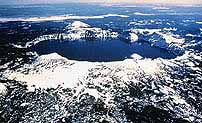
|
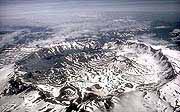
|
|
|
|
Crater Lake, Oregon, is the namesake of this caldera type. With a water depth of 600 m, Crater Lake is the deepest fresh-water lake in North America. The caldera walls rise above the lake level an additional 600 m. This large depression formed from the violent eruption and collapse of the ancestral stratovolcano Mt. Mazama about 6850 years ago. The massive eruption generated ~50 times more tephra than the Mt. St. Helens eruption in 1980. About 30 km of pyroclastic material erupted during the main plinian phase, thus depleting the magma chamber and leaving its roof unsupported. As ignimbrites erupted toward the end of the plinian phase, the volcano edifice began to collapse along ring fractures. The collapse generating additional pyroclastic sheet flows and a 10-km-wide caldera (see Mazama ignimbrite). The caldera has since been the site of several small eruptions which have covered parts of the caldera floor with andesitic to rhyolitic lava. The most voluminous of these post-caldera eruptions have built the volcanic cone of Wizard Island on the western side of the lake. These eruptions ceased about 2000 years ago.
|
|
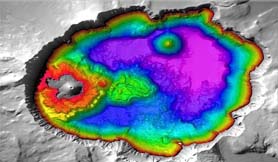 |
|
Crater Lake Caldera floor |
of the Crater Lake Caldera floor |
The two most recent eruptions associated with the generation of Crater-Lake type calderas are both from Indonesia -- the colossal eruption of Tambora in 1815, and the equally spectacular eruption of Krakatau in 1883.
The summit regions of many active shield volcanoes are marked by calderas. Hawaiian examples include the Mokuaweoweo caldera on Mauna Loa and the Kilauea caldera on Kilauea. Others include the Erta Al caldera in Ethiopia, the summit caldera of Piton del la Fournaise on Reunion Island, and the spectacular basaltic calderas on the shield volcanoes of the Galapagos Islands. Most basaltic shield volcano calderas on earth are 1-5 km in diameter. Those observed on Mars, however, are extraordinarily large, the largest being the Olympus Mons caldera, with a diameter of more than 60 km!
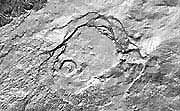
|
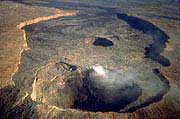
|
|
|
|
Whereas Crater-Lake type calderas are associated with the explosive eruption felsic magma, generating voluminous pyroclastic sheet flows, basaltic calderas are not produced by such catastrophic events. Instead, they subside in increments to produce a nested structure of pits and terraces, as shown in the photos above for the Kilauea caldera and the Erta Al caldera. Basaltic calderas like these are gradually enlarged by episodic collapse, due to the extraction of lava from shallow-level magma chambers underlying the summit areas.
Resurgent calderas are the largest volcanic structures on earth. They are associated with massive eruptions of voluminous pyroclastic sheet flows, on a scale not yet observed in historic times. The youngest of these resurgent calderas is the 74,000-year-old Toba Caldera on the Indonesian Island of Sumatra. The Toba eruption generated 2800 times more pyroclastic material than the moderate Plinian eruption of Mt. St. Helens in 1980! There are three resurgent calderas in the United States less than 1.5 million years old -- the Valles Caldera in New Mexico, the Long Valley Caldera in California, and the Yellowstone Caldera in Wyoming.
With diameters ranging from 15 to 100 km, resurgent calderas dwarf those of Crater-Lake type. They are similar to Crater-Lake type calderas in that they are also generated by crustal collapse above shallow magma chambers. Resurgent calderas, however, are too large to have been associated with a Crater-Lake type central volcano, like Mt. Mazama. Apart from their large size, the definitive feature of resurgent calderas is a broad topographic depression with a central elevated mass resulting from post-collapse upheaval of the caldera floor. Uplift is commonly more than one kilometer. The caldera floor is typically filled with rhyolitic lavas, obsidian flows, and domes, and the uplifted centers often contain elongate rifts (graben) along their crests.
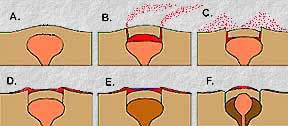 The
evolution of a resurgent caldera is depicted in the illustration
shown here (modified from Calvin J. Hamilton). Caldera formation
begins with crustal uplift associated with the arrival of a large
plume of gas-rich rhyolitic magma (A). Ring fractures propagate
outward from the chamber toward the surface and these are used
as conduits for escaping magma. Decompression of the magma results
in massive vesiculation
and the explosive eruption of tephra
into the high atmosphere (B). As the eruption wanes, pyroclastic
flows begin to erupt from the ring fractures. The magma
chamber is depleted and its crustal roof begins to collapse, generating
additional pyroclastic flows (C). As the eruption ends, hundreds
of meters of pyroclastic flows have now accumulated within the
caldera (inflow facies) and beyond the caldera walls
(outflow facies) (D). The floor of the caldera may
quickly be occupied by a lake (E). Resurgence of the caldera floor
takes about 1000 to 100,000 years to accomplish (F). This period
of uplift may be controlled by compression of the remaining magma
beneath the collapsed roof of the chamber, or by the arrival of
new magma into the chamber.
The
evolution of a resurgent caldera is depicted in the illustration
shown here (modified from Calvin J. Hamilton). Caldera formation
begins with crustal uplift associated with the arrival of a large
plume of gas-rich rhyolitic magma (A). Ring fractures propagate
outward from the chamber toward the surface and these are used
as conduits for escaping magma. Decompression of the magma results
in massive vesiculation
and the explosive eruption of tephra
into the high atmosphere (B). As the eruption wanes, pyroclastic
flows begin to erupt from the ring fractures. The magma
chamber is depleted and its crustal roof begins to collapse, generating
additional pyroclastic flows (C). As the eruption ends, hundreds
of meters of pyroclastic flows have now accumulated within the
caldera (inflow facies) and beyond the caldera walls
(outflow facies) (D). The floor of the caldera may
quickly be occupied by a lake (E). Resurgence of the caldera floor
takes about 1000 to 100,000 years to accomplish (F). This period
of uplift may be controlled by compression of the remaining magma
beneath the collapsed roof of the chamber, or by the arrival of
new magma into the chamber.
Three examples of resurgent calderas are described here: